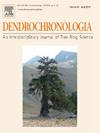甜板栗(Castanea sativa Mill.)对干旱的敏感性限制了其未来的适宜性
IF 2.7
3区 农林科学
Q1 FORESTRY
引用次数: 0
摘要
全球变暖和相关的干旱暴露了世界各地许多树种的脆弱性。因此,在适应性森林管理中,引进适应气候变化的树种是一个反复出现的话题。在这种情况下,甜栗子(Castanea sativa Mill.)由于其在地中海的本地分布而重新受到关注,地中海的气候与中欧未来的气候预测相对应。尽管甜栗树在整个欧洲的种植历史悠久,在林业方面具有巨大的潜力,但对甜栗树气候敏感性的研究仍然很少,特别是在其北部分布地区。通过比较德国西南部不同土壤水分有效度梯度下树轮数据的生长响应,对甜栗树的气候适应能力进行了评价。具体而言,比较了低、中、高水分有效度栗树林分的长期生长趋势、树木生长的气候敏感性和指标年的生长响应。板栗对春季和初夏干旱较为敏感,但变化趋势不明显。在6个站点中,有4个站点的长期增长下降也表明存在压力。将观察期划分为早期(1976-1999年)和后期(2000-2022年),表明气候敏感性降低,表明气候增长关系的非平稳性。干旱相关指标年的生长响应沿土壤水分有效性梯度相似,表现为低抗性和高弹性。我们的研究结果表明,甜栗子本身并不是一种适应气候变化的物种。鉴于初夏水分供应对板栗生长的重要性,我们建议仔细选择场地。尽管如此,甜栗子似乎是未来在水源较好的地区进行森林管理的一个有希望的选择。本文章由计算机程序翻译,如有差异,请以英文原文为准。
Future suitability of sweet chestnut (Castanea sativa Mill.) is limited by susceptibility to drought
Global warming and associated droughts have revealed the vulnerability of many tree species throughout the world. The introduction of climate-resilient tree species is therefore a recurring topic in adaptive forest management. In this context, sweet chestnut (Castanea sativa Mill.) is receiving renewed attention due to its native distribution in the Mediterranean, which climatically corresponds to future climate projections for Central Europe. Despite its long history of cultivation throughout Europe and its significant potential in forestry, studies on the climate sensitivity of sweet chestnut remain scarce, particularly in its northern distribution area. By comparing growth responses based on tree-ring data along a gradient of soil water availability in southwestern Germany, this study contributes to the evaluation of the climate resilience of sweet chestnut. More specifically, sweet chestnut stands of low, medium and high water availability were compared regarding long-term growth trends, climate sensitivity of tree growth and growth responses in pointer years. While trends were weak along the studied gradient, sweet chestnut was generally found to be sensitive to spring and early summer drought. At four out of six sites long-term growth decline also indicate stress. Splitting the observation period into an early (1976–1999) and late (2000–2022) period revealed a decrease in climate sensitivity, demonstrating non-stationarity of climate-growth relationships. Growth responses in drought-related pointer years were similar along the soil water availability gradient, and revealed low resistance and high resilience. Our findings indicate that sweet chestnut is not per se a climate-resilient species. Given the importance of early summer water availability for chestnut growth, we recommend a careful site selection. Nevertheless, sweet chestnut seems a promising option for future forest management on better water-supplied sites.
求助全文
通过发布文献求助,成功后即可免费获取论文全文。
去求助
来源期刊

Dendrochronologia
FORESTRY-GEOGRAPHY, PHYSICAL
CiteScore
5.50
自引率
13.30%
发文量
82
审稿时长
22.8 weeks
期刊介绍:
Dendrochronologia is a peer-reviewed international scholarly journal that presents high-quality research related to growth rings of woody plants, i.e., trees and shrubs, and the application of tree-ring studies.
The areas covered by the journal include, but are not limited to:
Archaeology
Botany
Climatology
Ecology
Forestry
Geology
Hydrology
Original research articles, reviews, communications, technical notes and personal notes are considered for publication.
 求助内容:
求助内容: 应助结果提醒方式:
应助结果提醒方式:


